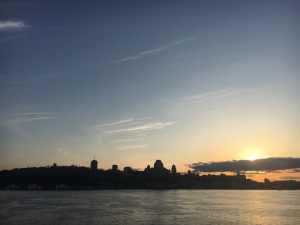Bonjour (or bonsoir, depending on when you are reading this). This is Hannah Ticoras taking over the blog for our last day in Quebec (the city) and Quebec (the province) whose name (Quebec, Quebec), I agree, is very confusing. This, I guess is hypocritical, but c’est la vie.
This morning’s wake up was difficult for everyone after a late night on the ferry and the Funiculaire du Vieux-Québec. Spirits were rising as we got on the bus after a quick breakfast this morning.
Our day started at Montmorency Falls, one of the tallest waterfalls in North America at a whopping 276 feet. For comparison, that’s like if you stacked a MTA bus (nose to tail) on top the Barclays Center, and then stacked THAT on top of Niagara Falls (172 feet). Pretty dang tall.
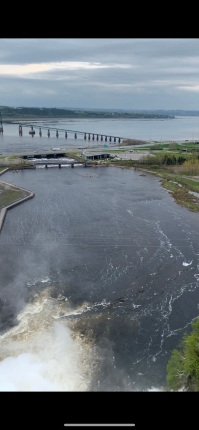
Monmorency dumps about 10 thousand gallons of water per second over it’s falls (parse compared to the ~757, 500 gallons per second over Niagara), BUT we were able to see it from two beautiful views: from the top and the bottom. (Take that Niagara!)

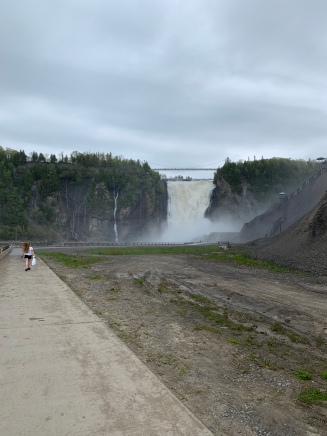
Usually, there are panoramic stairs that allow visitors to gain access to a full side view of the Falls, as well as a tram that takes you up the side, neither of which we took (the stairs were closed to renovation). However, this did not stop our kids from running AS CLOSE AS POSSIBLE to the roar of the water, resulting in many, many damp children.
“No regrets!” they exclaimed, as they emerged dripping from the water. And it didn’t seem like there were any at all.


The mist off the falls is famous, gaining the name le «pain de sucre» for the icing sugar effect the freezing mist has on the surrounding rocks in the wintertime. Imagine the First Peoples that discovered this waterfall, and the surprise of the Europeans when they arrived to explore and colonize this land. One cannot help but be awestruck.
On the way to our next destination, I asked our tour guide, Chuck, to explain the difference between the words chateau, maison and chez, all of which I had heard used to describe places where people live.
“Chateau is a castle,” he explained, like the Chateau du Frontenac we saw yesterday. Maison, that’s just a house. And Chez, well, that basically means at. So it means you’re at someone’s place. Like if I were to say Chez Gaston, that would mean it was Gaston’s place. Which is why many restaurants use this in their title, including the place were are going to, Chez Marie.”
Chez Marie, located in the Château-Richer region and housed in a stone house dating back to 1652, is a bakery and boutique owned for 90 years by grandmother, and now granddaughter Marie Mercier (they share the same name). Each day, Marie bakes bread for hungry travelers and groups alike, smothered in, you guessed it, maple butter. We ate our mid-morning snack amongst wooden benches and old hockey memorabilia, an experience that can only be described as delightfully Canadian.
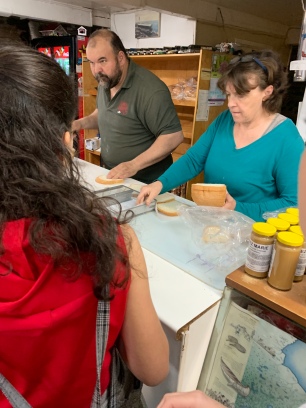
Before heading to lunch, we visited the St. Anne’s Basilica. Though the current Basilica was built in 1922, sacred chapels and churches have existed on this site for over 350 years. We were lucky enough to catch the end of a mass, and heard beautiful organ music as people left.

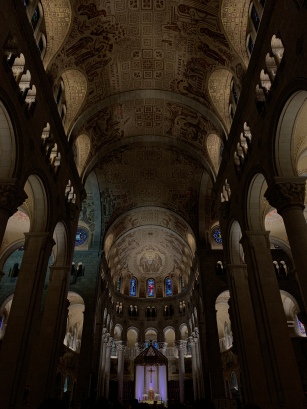
The stained glass surrounding the edge of the chapel commemorates other cities which have churches dedicated to St. Anne or, her daughter, St. Mary. The style of the font was very cool and struck me as distinctively of the Art Deco movement.

Lunch was a quick one, as we still had 2 museum visits and final shopping time to budget in. Our first museum was the Albert Gilles Copper Museum where we learned the process of mining copper from the ground, saw beautiful art from around the world, and witnessed a demonstration of the necessary technique for making intricate designs. We also learned that the U.S. is the 4th largest purchaser of copper worldwide!

Next stop was Le Museé de la Civilisation, a wonderfully modern museum situated on the shores of the St. Lawrence River. Students had a choice of 4 exhibitions, most notably one titled C’est nostre historie about the past and present lives of First Nations and Indigenous Peoples in the Quebec region. Students made connections to their prior knowledge of Indigenous People’s in the Americas from their Humanities curriculum in 7th grade, and observed the challenges and victories that still face Indigenous Peoples to this day. An video installation titled Living in the City: The Art of the City demonstrated this beautifully. Created by an Indigenous man living in Montreal, the video depicts various people rowing boats down roughly drawn streets, highlighting the disconnect between the two cultures. The students picked up on this disconnect as well, noting that the separation between the native land and the city makes things challenging, especially when there are more jobs in the city.
With a final bit of time of shop and socialize in Old Quebec, we stopped off for our final dinner at Café De Paris. Our appetizer of veggie soup was accompanied by a accordion player who miraculously played the most uplifting version of Leonard Cohen’s Hallelujah that we have ever heard. (Mark and I both agreed that this cover is our favorite). After dinner found us back at our hotel, packing and searching desperately for that one lost sock.
44 kids, 5 adults, 1 bus driver and a tour guide. All in all, this trip has been fantastic. Traveling to new places can be stressful and blissful and existential and exciting and earth-shattering and overwhelming and life-affirming. This trip was all of those things. If I am left with one understanding, it is of the importance of the amalgamation of the old and the new. Listening to 7th graders from Brooklyn discuss their ideal tax bracket structure while descending hills in Old Quebec. Witnessing natural wonders like the Montmorency Falls while questioning the role that Britain and France had on Indigenous People who lived there. Getting half a bus to dance to a pop song from 2003 after leaving a 350-year-old Basilica (thanks to our tour guide Chuck for that).
Growing is about learning, and learning is all about making connections, about forging new paths while not obfuscating those that came before. I hope that this trip was a new path for our students, and that it introduced them to histories, cultures, and ways of life outside of their own and that, ultimately, it helps them to make their own story of the future.
I also cannot wait to see my cat.
One breakfast and 10 bus hours away from all of you in New York. Wish us luck and safe travels. Bonne nuit!










